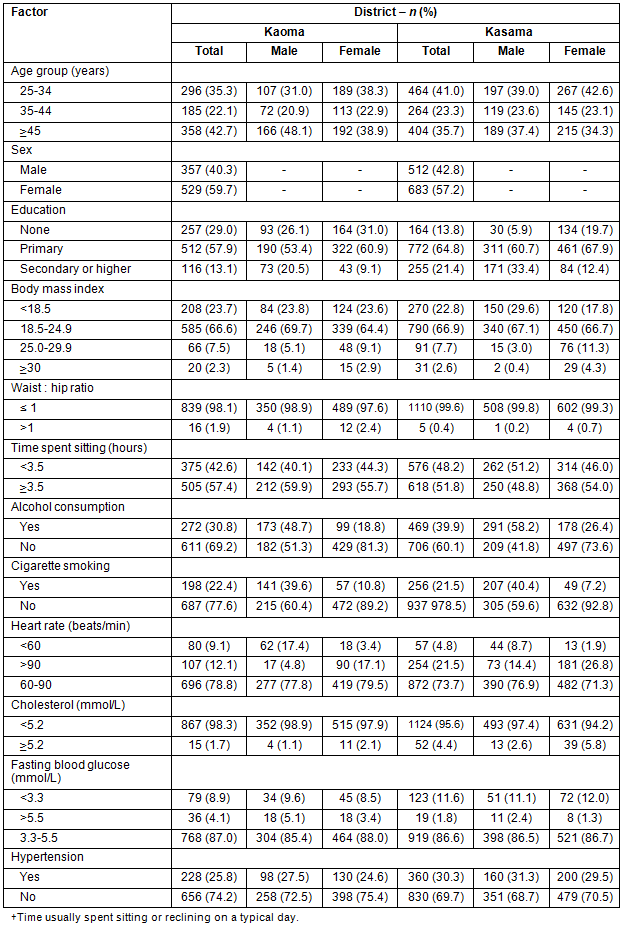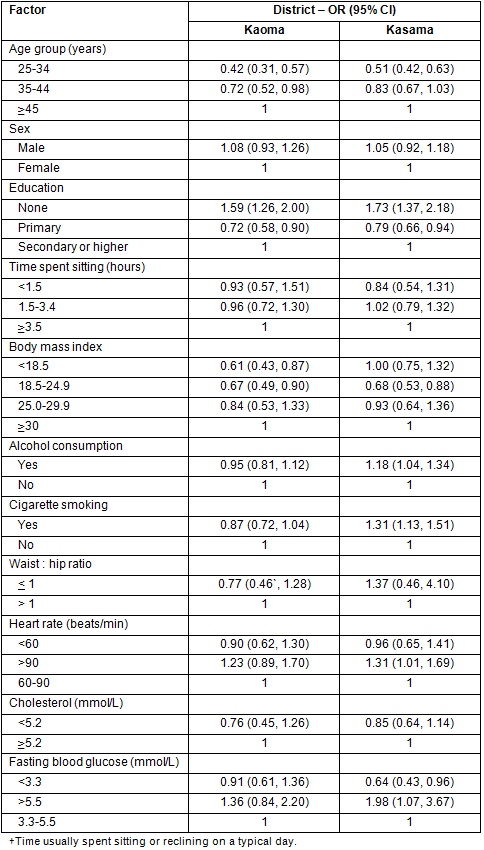Hypertension is a public health challenge worldwide with an increasing trend in developing countries. Chronic non-communicable diseases (NCD) such as hypertension account for approximately 60% of the 56.5 million deaths each year and almost half (46%) of the global burden of disease1. Hypertension is a major risk factor for cardiovascular disease2 and is the most widely recognized modifiable risk factor for cardiovascular disease, cerebrovascular disease (stroke) and end-stage renal disease3. Hypertension is responsible for one in eight deaths worldwide1. Control of hypertension is an effective means for reducing premature cardiovascular disease mortality4.
In developing countries such as Zambia, hypertension adds to the double burden of communicable and NCD in a resource-low environment characterised by an ineffective health system. The pace of change and adoption of western lifestyles in developing countries5 suggests that existing health systems will soon be overburdened. Costly and prolonged care of patients with hypertension or hypertension-related disease in low- and middle-income countries can divert scarce family and societal resources to medical care. Consequently, lower socio-economic groups have greater prevalence of risk factors, higher incidence of disease and higher mortality.
In Zambia the Ministry of Health has developed policies and strategies to mitigate the increasing burden of NCD. A separate budget and a unit has been created in the Ministry of Health structure specifically dedicated to NCDs. With support from WHO, the Ministry commissioned a NCD survey to identify the magnitude of the problem.
Recently, hypertension has been reported as prevalent in urban populations in Zambia at 34.8% in Lusaka, with major risk factors including age, alcohol use and stress6; and in Kitwe at 31.1% with risk factors age and BMI7. As in many other developing countries, hypertension has not been considered a public health problem in Zambia. Therefore public health research in Zambia, particularly rural Zambia, has not considered hypertension or its differential risk factors and patterns of the disease. This study was conducted to determine the prevalence of hypertension and its correlates in the two rural districts of Zambia, namely Kaoma and Kasama.
Study area
The administrative, political structure of Zambia is according to provinces, districts, constituencies and wards. At the time of the survey, Zambia was divided into 9 provinces and 72 districts. Kaoma and Kasama districts were predominantly rural districts with population sizes of 162 568 and 170 929, respectively8. The proportions for males in Kaoma and Kasama were 48% and 49%, respectively. The major economic activity for these districts is subsistence farming.
There are five levels of health care in Zambia namely: 3rd-level hospitals also called specialist or tertiary hospitals, the highest referral hospitals in Zambia; 2nd-level hospitals also referred to as provincial or general hospitals and found at provincial level; 1st-level hospitals also called district hospitals found at district level; then health centres, and health posts. Kaoma had 4 level-1 hospitals, 28 health centres and 2 health posts. Kasama had 1 level-2 hospital, 25 health centres and 8 health posts.
Kaoma district was one of the 8 districts in Western province. Kaoma had 3 constituencies with a total of 20 wards. Kasama district was one of the 12 districts in Northern province. It had 2 constituencies with a total of 15 wards.
Study design and participants
A cross-sectional study using a modified World Health Organization (WHO) global NCD surveillance initiative NCD-STEPwise approach was used in this study9.
A Statcal program in EPI INFO v6.04 (www.cdc.gov/epiinfo/) was used to estimate the sample size. With a 50% prevalence rate estimated (as no estimate existed) to be within 5%, 8 provinces and a design effect of 2, a sample size of 6128 was obtained. After adjusting for 80% response rate, a sample size of 7660 was obtained. By the end of a series of surveys to be conducted country-wide, 7660 participants would have been recruited. The sample size was proportionally allocated to 8 provinces, and powered to produce estimates at provincial level and thus country level. Of the 7660 participants, 843 were to be selected from Kasama and 766 from Kaoma. Sample sizes were increased to 893 in Kaoma and 1196 in Kasama due to extra reagent strips for glucose and cholesterol estimation being close to expiry.
A multi-stage sampling technique was used for participants in both districts. Firstly, wards were randomly selected from each constituency. In the second stage of sampling, standard enumeration areas (SEAs) proportional to the ward size were selected. Finally from the selected SEAs, households were systematically sampled. All individuals (male or female) aged 25 years or older in a selected household were eligible to participate in the study.
Data collection and definitions
Data collection: A modified WHO STEPwise questionnaire9 consisting of sections on behavioural measurements (Step 1), physical measurements (Step 2) and biochemical measurements (Step 3) was used to collect data. Interviews were conducted at homesteads with some measurements being conducted in private areas of the homestead. Cards were shown to explain some of the terms used in obtaining behavioural measurements.
Definitions: Blood pressure Blood pressure readings were taken using the Omron Digital Automatic BP Monitor M4-1 (OMRON Healthcare; Europe BV, The Netherlands). Three readings were obtained at an interval of 3 min and an average of the three readings was considered the final reading for blood pressure. Blood pressure readings were taken after the questionnaire was administered, allowing participants to have rested for 15 min prior to measurements.
Height and weight Height and weight measurements were taken after the blood pressure readings. The Seca Brand 214 Portable Stadiometer (Secagmbh kg; Hamburg, Germany) was used to measure the height in centimetres. Weight was measured in kilograms using the Heine Portable Professional Adult Scale 737 (Secagmbh kg; Hamburg, Germany).
Waist and hip circumferences Centimetre measurements for waist and hip circumferences were taken in a private area using a Figure Finder Tape MeasureÒ. Waist and hip circumferences were the last physical measurements that were taken.
Heart rate Heart rate was recorded in beats per minutes using the ORMRON digital automatic blood pressure monitor M4-1 (OMRON Healthcare Europe; The Netherlands). Heart rate and blood pressure readings were taken simultaneously.
Cholesterol and glucose The Accutrend GCT (Glucose, Cholesterol and Triglycerides) Meter Three-in-One system (Roche Diagnostics GmbH; Mannheim, Germany) was use to estimate total cholesterol and fasting glucose levels, recorded in mmol/L. Blood tests were conducted after participants had fasted for at least 12 hours.
Body mass Index & hypertension BMI was categorized as <18.5 (underweight), 18.5-24.9 (normal weight), 25-29.9 (overweight), and >30 (obese); waist:hip ratio was either <1 (normal) or >1 (raised); participants with blood pressure >140/90 were considered to have hypertension9. Participants who were taking antihypertensive medication were included in the high blood pressure group.
Other Information on the education status for the participants was obtained by asking: What is the highest level of education you have completed? (responses: no formal schooling, less than primary school, primary school completed, lower secondary school completed, upper secondary school completed, college/university completed, or refused). Due to small numbers in some of these categories, the responses were combined as: none, primary or secondary/higher. Smoking was defined as current smoking and participants were asked: Do you currently smoke any tobacco products, such as cigarettes, cigars or pipes? Variable alcohol consumption was obtained by asking: Have you consumed alcohol (such as beer, wine, spirits, fermented cider or within the past 30 days? Time usually spent sitting or reclining on a typical day was categorised as: <1.5, 1.5-3.4 or ≥3.5 hours. A waist:hip ratio of more than 1 was considered 'high'. Heart rate of over 90 beats/min was considered 'high'. Cholesterol values of ≥5.2 mmol/L were considered raised; and fasting blood glucose levels of > 5.5 mmol/L were considered 'high' (manufacturer's recommendation: 2007 Roche Diagnostics GmbH).
Data management and analysis
Two clerks entered data into Epi Data software via a screen with embedded consistency and range checks. Data were double entered and validated. The validated data were exported to SPSS v11.5 (www.spss.com) for analysis.
Proportions of the outcome variables and socio-demographic variables were calculated. Bivariate and multivariate logistic regression analyses were conducted. Proportions were compared using Yates' corrected χ2 test, and a result yielding a p-value of less than 5% was considered significant. Factors that were significantly associated with the outcome in bivariate analyses were considered in a multivariate logistic regression analysis using a backward variable selection method. Odds ratios (unadjusted odds ratios [OR] & adjusted odds ratios [AOR]) and their 95% confidence intervals (CI) are reported.
Ethics approval
The study protocol was reviewed and approved by the University of Zambia (UNZA) Biomedical Research Ethics Committee (#016-08-07). Permission to conduct the survey was obtained from the Ministry of Health [Zambia]. Informed consent was obtained after interviewer explanation of the benefits and risks for taking part in the study. Entry forms were viewed only by approved study personnel.
There were 895 and 1198 survey participants, respectively, from Kaoma and Kasama. A description of the sample is presented (Table 1). The proportion of male participants was similar between the two districts (40.3% in Kaoma & 42.8% in Kasama, p=0.262).
Table 1: Description of the sample stratified by district

Male participants in Kaoma tended to be older than those in Kasama (42.7% vs 35.7% were ≥45 years, respectively; p=0.007) but no significant difference in the distribution of age was observed among female participants (p=0.238). While males (48.1% ≥45 years) were significantly older than females (38.9% ≥45 years) in Kaoma, no significant difference was observed in Kasama (p=0.435).
Both males and females in Kasama tended to be more educated than those in Kaoma (p<0.001), with 13.1% of participants in Kaoma and 21.4% in Kasama having secondary or higher education. In both districts, males were more educated than females (20.5% vs 9.1%, respectively, p<0.001, in Kaoma; 33.4 vs 12.4%, p<0.001, in Kasama).
Overall 6.5% of males and 12.0% of females in Kaoma (p=0.062) were overweight/obese, compared with 3.4% of males and 15.6% of females in Kasama (p<0.001). Overall 1.9% of participants in Kaoma and 0.4% of participants in Kasama had a waist:hip ratio of >1 . More than half participants (57.4% in Kaoma & 51.8% in Kasama) usually spent ≥3.5 hours sitting or reclining on a typical day. In both Kaoma and Kasama, significantly more males consumed alcohol (48.7% vs 18.8% females, p<0.001 in Kaoma; 58.2% vs 26.4%, p<0.001 in Kasama). Similarly, regarding smoking, 39.6% of males and 10.8% (p<0.001) of females in Kaoma smoked cigarettes, as did 40.4% of males and 7.2% of females (p<0.001) in Kasama. High levels (>5.2 mmol/L) of cholesterol were recorded in 1.1% of males and 2.1% of females (p=0.409) in Kaoma; and 2.6% of males and 5.8% of females (p=0.011) in Kasama. Raised fasting glucose levels of >5.5 mmol/L were recorded in 5.15 of males and 3.4% of females (p=0.300) in Kaoma; and 2.4% of males and 1.3% of females (p=0.291) in Kasama. In both Kaoma and Kasama, more females than males had heart rates >90 beats/min (17.1% vs 4.8%, p<0.001 in Kaoma; 26.8% vs 14.4%, p<0.001 in Kasama, respectively).
Overall, 25.8% (27.5% males & 24.6% females; p=0.373) of the participants in Kaoma and 30.3% (31.3% males & 29.5% females; p=0.531) of the participants in Kasama were hypertensive.
In bivariate analyses, the following factors were significantly associated with hypertension in Kaoma: age, education and BMI (Table 2). However, in Kasama, the significant factors were age, education, BMI, alcohol, smoking, heart rate, and fasting blood glucose.
In Kaoma, age and BMI were independently associated with hypertension (Table 3). Compared with participants aged 45 years and older, participants of 25-34 years were 60% (AOR=0.40, 95% CI [0.21, 0.56]) less likely to be hypertensive. Participants with BMI <18.5 and 18.5-24.9 were 54% (AOR=0.46, 95% CI [0.30, 0.69]) and 31% (AOR=0.69, 95% CI [0.49, 0.98]) less likely to be hypertensive compared with participants with BMI ≥30.
In Kasama, the factors that were significantly associated with hypertension in multivariate analysis were age, smoking and heart rate (Table 3). Participants of 25-34 years were 49% (AOR=0.51, 95% CI [0.41, 0.65]) less likely to be hypertensive compared with participants aged 45 years and older. Compared with participants who were non-smokers, smokers were 21% (AOR=1.21, 95% CI [1.02, 1.45]) more likely to be hypertensive. Participants with heart rate >90 beats/min were 59% (AOR=1.59, 95% CI [1.17, 2.16]) more likely to be hypertensive compared with participants with heart rate 60-90 beats/min.
Table 2: Factors associated with hypertension in bivariate analyses stratified by district

Table 3: Independent factors associated with hypertension in multivariate analysis stratified by district

Discussion
The rural community-based hypertension survey among adult residents of Kaoma and Kasama districts of Zambia, revealed that Kasama residents had a higher prevalence of hypertension (30.3% vs Kaoma in 25.8%). This prevalence of hypertension in both rural districts of Zambia is relatively lower than the 34.8% prevalence reported in urban Zambia (capital city Lusaka)6. These findings are consistent with the results of a community survey among 1798 urban and rural Cameroonians5. Although hypertension is more prevalent in urban areas, the high levels found in rural Zambia demand that interventions be focused equally on urban and rural populations.
The prevalence of hypertension in Kasama was close to that reported for Lusaka, and this could be due to Kasama's semi-urban characteristics, as can be seen in the education demographic results. These findings in Kasama are consistent with a study of Lowenthal et al in the Northern province of Zambia (where Kasama is located), which revealed that hypertension had a central causative role in massive cardiomegaly in that location10. Compared with findings from East Africa, Kaoma and Kasama had higher prevalences of hypertension than the 22% reported by Maher et al11 in rural Uganda and 23.7% reported by Muhihi et al12 in an urban setting of Mwanza, Tanzania.
In neither district in the present study was there a significant gender difference in the prevalence of hypertension. These findings are inconsistent with that of an urban study in Lusaka, Zambia, where males were found to be more likely to have hypertension6. In a similar study conducted in Tanzania by Njelekela et al13, males were more at risk of hypertension, while Wamala et al14 in Uganda reported that hypertension was more likely in females. The finding of no gender difference in the current study suggests that interventions should be cross-gender in rural parts of Zambia.
In both Kaoma and Kasama, age was significantly associated with hypertension in the multivariate analysis. This is similar to a result obtained in a survey conducted in the capital city of Zambia, Lusaka6. Research has generally shown that the prevalence of hypertension increases with age. According to Burt et al, more than half of people aged 60-69 years and approximately three-fourths aged 70 years and older are affected15. Vasan et al also noted that age-related rise in systolic blood pressure is primarily responsible for an increase in both the incidence and prevalence of hypertension with increasing age16. However, interventions should also be targeted to younger age groups.
In addition to age, in the Kasama sample, smoking and heart rate were independently associated with hypertension; while, in Kaoma it was only BMI. The situation of Kaoma presents a contrasting phenomenon of overweight/obesity (ie BMI ≥25) among people of low socioeconomic status in a rural setting. However, these findings are consistent with those from previous studies that have reported a strong association between hypertension and BMI6,17. This phenomenon of overweight/obesity in low socioeconomic settings has been reported elsewhere1, where malnutrition was found to coexist with overweight/obesity in low- and middle-income countries, contributing to the growing disease burden in these populations.
When compared with the findings from Lusaka, Zambia6, the risk factors (from multivariate analysis) of the Kaoma residents are a subset of Lusaka residents, while Kasama's smoking and heart rate were not included in findings in the Lusaka survey. These contrasting risk factors may reflect the differing developmental stages of these two rural districts. This finding further indicates the importance of establishing risk factors for hypertension in specific locations, rather than inferring results from one location to another. No literature was found for comparison regarding smoking and heart rate in rural settings. However, studies have shown that smoking is becoming more prevalent in developing than developed countries18. Its association with hypertension has been clearly demonstrated19.
Although previous studies have reported a positive relationship between hypertension and low education20,21, no significant association was observed between education and hypertension in the present study. However, interestingly, Kasama males and females, with higher education levels than those in Kaoma, had a higher prevalence of hypertension. This is in contrast to studies that suggest low education may mean a lack of awareness of risk factors for hypertension22, the presence of inadequate diet, and a lack of access to medical care21.
No significant associations were observed in the current study between alcohol and fasting blood glucose, and hypertension in either district. The reasons for this is are unclear.
Limitations
Because the study was cross-sectional, it was not possible to attribute the significant associations observed in the study as being casual. It was not possible to verify that participants had fasted for at least 12 hours before taking biochemical measurements. Estimates might have been overestimated to the extent participants did not fast for at least 12 hours. During the survey, most participants worked in their fields and had their first meal when they returned to their homesteads. However, food was scarce during the growing season and therefore an introduced bias would have been minimal. Despite taking blood pressure and heart rate readings after administering the questionnaire, some participants may still have been anxious when research assistants entered their homesteads, leading to increased heart rate and blood pressure, thus overestimating the prevalence of hypertension. However, it was not possible to estimate the magnitude of bias due to the 'research assistant effect'. Overall, the authors believe that the estimates we obtained in the study reflected the magnitudes of hypertension and its risk factors in the rural areas of Zambia.
The findings of the current study reveal that hypertension is prevalent among rural residents in Kaoma and Kasama, Zambia. The disease is highly associated with age, BMI, smoking and heart rate. Given that the correlates for hypertension were not uniform between districts, there is a need for efficient preventive strategies to halt the trend of non-communicable diseases that are district/province-specific in Zambia, through the control of risk factors highlighted in this study.
Acknowledgements
The study participants are thanked for their cooperation with the study procedures, and the World Health Organization Zambia country office for funding the survey. The authors are grateful to their research assistants who worked tirelessly to successfully conduct the surveys, even during Christmas and new year holidays.
References
1. WHO. World Health Report 2002. Reducing Risks, Promoting Healthy Life. Geneva: World Health Organization, 2002.
2. Wang TJ, Vasan RS. Epidemiology of uncontrolled hypertension in the United States. Circulation 2005; 112(11): 1651-1662.
3. Ingelsson E, Gona P, Larson MG, Lloyd-Jones DM, Kannel WB, Vasan RS et al. Altered blood pressure progression in the community and its relation to clinical events. Archives of Internal Medicine 2008; 168(13): 1450-1457.
4. Khot UN, Khot MB, Bajzer CT, Sapp SK, Ohman EM, Brener SJ et al. Prevalence of conventional risk factors in patients with coronary heart disease. JAMA 2003; 290(7): 898-904.
5. Poulter N, Khaw KT, Hopwood BE, Mugambi M, Peart WS, Rose G et al. Blood pressure and its correlates in an African tribe in urban and rural environments. Journal of Epidemiology & Community Health 1984; 38(3): 181-185.
6. Goma FM, Nzala SH, Babaniyi O, Songolo P, Zyaambo C, Rudatsikira E et al. International Archives of Medicine 2011; 4: 34.
7. Siziya S, Rudatsikira E, Babaniyi O, Songolo P, Mulenga D, Muula AS. Prevalence and correlates of hypertension among adults aged 25 years or older in a mining town of Kitwe, Zambia. Journal of Hypertension 2012; 1: 3.
8. Central Statistical Office. Summary report for the 2000 census of population and housing. Lusaka: CSO, 2003.
9. WHO. WHO STEPS surveillance manual: The WHO STEPwise approach to chronic disease risk factor surveillance. Geneva: World Health organization, 2005.
10. Lowenthal MN, Jones IG. Cardiomegaly in Northern Zambia: clinico-pathological observations. Transactions of the Royal Society of Tropical Medicine and Hygiene 1983; 77(3): 391-396.
11. Maher D, Waswa L, Baisley K, Karabarinde A, Unwin N. Epidemiology of hypertension on low-income countries: a cross-sectional population-based study in rural Uganda. Journal of Hypertension 2011; 29(6): 1061-1068.
12. Muhihi A, Njelekela M, Mpembeni R, Masesa Z, Kitamori K, Mori M et al. Physical activity and cardiovascular disease risk factors among young and middle-aged men in urban Mwanza, Tanzania. Pan African Medical Journal 2012; 11: 11.
13. Njelekela MA, Mpembeni R, Muhihi A, Mligiliche NL, Spiegelman D, Hertzmark E et al. Gender-related differences in the prevalence of cardiovascular disease risk factors and their correlates in urban Tanzania. BMC Cardiovascular Disorders 2009; 9: 30.
14. Wamala JF, Karyabakabo Z, Ndungutse D, Guwatudde D. Prevalence factors associated with hypertension in Rukungiri district, Uganda - a community-based study. African Health Sciences 2009; 9(3): 153-160.
15. Burt VL, Whelton P, Roccella EJ, Brown C, Cutler JA, Higgins M et al. Prevalence of hypertension in the US adult population. Results from the Third National Health and Nutrition Examination Survey, 1988-1991. Hypertension 1995; 25(3): 305-313.
16. Vasan RS, Beiser A, Seshadri S, Larson MG, Kannel WB, D'Agostino RB et al. Residual lifetime risk for developing hypertension in middle-aged women and men: The Framingham Heart Study. JAMA 2002; 287(8): 1003-1010.
17. Hamuyun A, Shab AS, Sultana R. Relation of hypertension with body mass index and age in males and female population of Peshawar, Pakistan. Journal of Ayub Medical College Abbottabad 2009; 21(3): 63-65.
18. WHO. WHO report on the global tobacco epidemic, 2008. The Mpower package. http://www.who.int/tobacco/mpower/mpower_report_full_2008.pdf (Accessed 6 September 2012).
19. Virdis A, Giannarelli C, Neves MF, Taddei S, Ghiadoni L. Cigarette smoking and hypertension. Current Pharmaceutical Design 2010; 16(23): 2518-2525.
20. Hoang VM, Byass P, Dao LH, Nguyen TK, Wall S. Risk factors for chronic disease among rural Vietnamese adults and the association of these factors with socio-demographic variables: findings from the WHO STEPS survey in rural Vietnam, 2005. Preventing Chronic Disease 2007; 4(2): A22.
21. Grotto I, Huerta M, Sharabi Y. Hypertension and socioeconomic status. Current Opinion in Cardiology 2008; 23(4): 335-339.
22. Samal D, Greisenegger S, Auff E, Lang W, Lalouschek W. The relation between knowledge about hypertension and education in hospitalized patients with stroke in Vienna. Stroke 2007; 38(4): 1304-1308.



